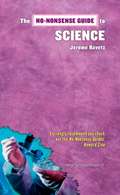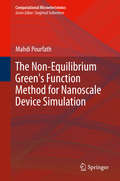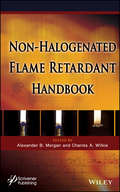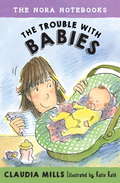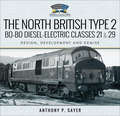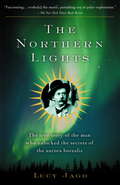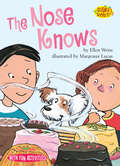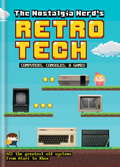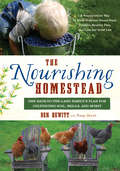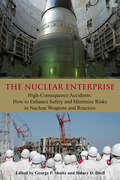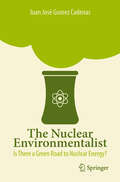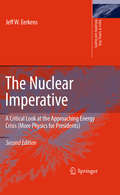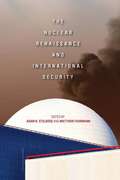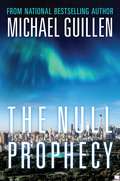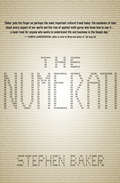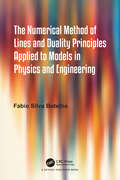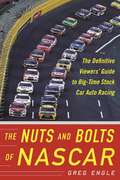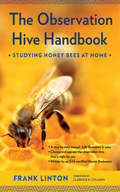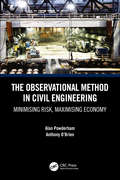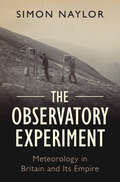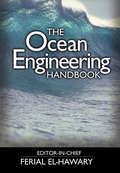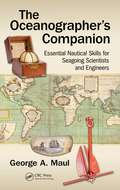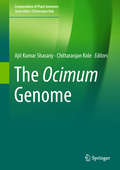- Table View
- List View
The No-Nonsense Guide to Science
by Jerome RavetzScience is the great intellectual adventure, but can also be an instrument of profit, power, and privilege. Wrongly used, it might yet make the twenty-first century our last. To make sense of this, we need to let go of old ideas and assumptions.<P><P>This No-Nonsense Guide to Science introduces a new way of thinking about science, moving away from ideas of perfect certainty and objectivity. We must accept uncertainty and ignorance in the field, as well as the need for citizens' participation in the policies involving science.
The Non-Equilibrium Green's Function Method for Nanoscale Device Simulation
by Mahdi PourfathFor modeling the transport of carriers in nanoscale devices, a Green-function formalism is the most accurate approach. Due to the complexity of the formalism, one should have a deep understanding of the underlying principles and use smart approximations and numerical methods for solving the kinetic equations at a reasonable computational time. In this book the required concepts from quantum and statistical mechanics and numerical methods for calculating Green functions are presented. The Green function is studied in detail for systems both under equilibrium and under nonequilibrium conditions. Because the formalism enables rigorous modeling of different scattering mechanisms in terms of self-energies, but an exact evaluation of self-energies for realistic systems is not possible, their approximation and inclusion in the quantum kinetic equations of the Green functions are elaborated. All the elements of the kinetic equations, which are the device Hamiltonian, contact self-energies and scattering self-energies, are examined and efficient methods for their evaluation are explained. Finally, the application of these methods to study novel electronic devices such as nanotubes, graphene, Si-nanowires and low-dimensional thermoelectric devices and photodetectors are discussed.
The Non-halogenated Flame Retardant Handbook
by Alexander B. Morgan Charles A. WilkieDue to the emphasis on replacing halogenated flame retardants with alternate technologies, this handbook contains in one place all of the current commercial non-halogenated flame retardant technologies, as well as experimental systems near commercialization. This book focuses on non-halogenated flame retardants in a holistic but practical manner. It starts with an overview of the regulations and customer perceptions driving non-halogenated flame retardant selection over older halogenated technologies. It then moves into separate chapters covering the known major classes of non-halogenated flame retardants. These chapters are written by known experts in those specific chemistries who are also industrial experts in how to apply that technology to polymers for fire safety needs. The handbook concludes with some of the newer technologies in place that are either niche performers or may be commercial in the near future. Future trends in flame retardancy are also discussed.The Non-Halogenated Flame Retardant Handbook book takes a practical approach to addressing the narrow subject of non-halogenated flame retardancy. This includes more emphasis on flame retardant selection for specific plastics, practical considerations in flame retardant material design, and what the strengths and limits of these various technologies are. Previous flame retardant material science books have covered non-halogenated flame retardants, but they focus more on how they work rather than how to use them.
The Nora Notebooks, Book 2: The Trouble with Babies
by Claudia Mills Katie Kath"The thought-provoking reflections on personality and growth add insight and discussability."--The Bulletin of the Center for Children's Books Fourth grade scientists are not meant to be babysitters. The second book in the Nora Notebooks finds Nora Alpers in unfamiliar territory. Nora Alpers has just become a ten-year-old aunt. To prepare for the new arrival, Nora has been writing down baby-related facts in her special notebook, just like she does with her favorite subject: ants. She likes the idea that someone who studies the A-N-T is also an A-U-N-T, even though she doesn't know anything about taking care of babies. A new family member isn't the only thing stressing Nora out. At school, Nora has to write journals in the voice of a pioneer on the Oregon Trail and prepare for the annual science fair. Science is normally Nora's best subject--until Nora ends up being paired with science-hating, cat-obsessed Emma! How will Nora ever learn to be a good aunt if she's trying to survive the Oregon Trail and arguing against Emma's unscientific science-fair ideas? Readers will welcome the return of Nora who Publishers Weekly called "delightful[ly] enterprising" in a starred review.From the Hardcover edition.
The Nora Notebooks, Book 3: The Trouble with Friends
by Claudia Mills Katie KathThe final book in the Nora Notebooks series finds Nora trying to navigate the unscientific matter of making friends with someone you have nothing in common with. Nora Alpers, fourth-grade scientist, likes things to be just so. Her ant farm, her hobbies, her friends. So when Coach Joe, her teacher, informs the class that all the students have to try something new and write a report about it, Nora is not pleased. She is even less pleased when her classmate Emma seems to decide that befriending Nora will be her “new” thing. Does Emma really want to be friends or is this just an assignment for school? Nora, meanwhile, has to figure out her own new thing. Will she discover that she has interests outside of science or will all her efforts end up being nothing but trouble? Praise for the Nora Notebooks series: “Will resonate with children who have a passion for something out of the ordinary.” —Publishers Weekly, starred “Readers will be drawn into the story by the sincere and realistic characters Mills has created, as well as the pleasing and appealing illustrations found in every chapter.” —School Library Journal “Middle-grade readers will hope for more Nora Notebooks soon.” —Kirkus Reviews
The North British Type 2 Bo-Bo Diesel-Electric Classes 21 & 29: Design, Development and Demise (Locomotive Portfolios)
by Anthony P. SayerThis comprehensive history of these unique locomotives covers everything from performance issues to sightings, detail differences and liveries. The Type 2 Bo-Bo Diesel-Electric Classes 21 & 29 locomotives were constructed by the North British Locomotive Company in the early 1960s. Used in the Scottish region of British Railway, they ran into numerous problems and were withdrawn from service within a decade. Due in part to their short careers, these locomotives remain something of a mystery to train enthusiasts. The scant information available on them is very often riddled with misinformation. This authoritative volume corrects the record, presenting the most comprehensive and accurate account of the NBL Classes 21 & 29. Fully illustrated with photographs and detailed line drawings, this volume offers individual locomotive histories, complete technical specifications, accident and fire damage reports, storage histories, and a complete account of their disposal at both private companies and Glasgow Works.
The Northern Lights: The True Story Of The Man Who Unlocked the Secrets of the Aurora Borealis
by Lucy JagoScience, biography, and arctic exploration coverage in this extraordinary true story of the life and work of Norwegian scientist Kristian Birkeland, the troubled genius who solved the mysteries of one of nature's most spectacular displays. Captivated by the otherworldly lights of the aurora borealis, Birkeland embarked on a lifelong quest to discover their cause. His pursuit took him to some of the most forbidding landscapes on earth, from the remote snowcapped mountains of Norway to the war-torn deserts of Africa. In the face of rebuke by the scientific establishment, sabotage by a jealous rival, and his own battles with depression and paranoia, Birkeland remained steadfast. Although ultimately vindicated, his theories were unheralded-and his hopes for the Nobel Prize scuttled-at the time of his suspicious death in 1917. The Northern Lightsoffers a brilliant account of the physics behind the aurora borealis and a rare look inside the mind of one of history's most visionary scientists.
The Nose Knows (Science Solves It!)
by Ellen WeissA Parent's Choice Recommended BookSolve kid-sized dilemmas and mysteries with the Science Solves It! series. These fun books for kids ages 5–8 blend clever stories with real-life science. Why did the dog turn green? Can you control a hiccup? Is that a UFO? Find the answers to these questions and more as kid characters dive into physical, life, and earth sciences. Everyone in the family has a cold - except Peter. Who will sniff out the funny smells? By default, Peter becomes the family nose - until he, too, catches a cold. Books in this perfect STEM series will help kids think like scientists and get ahead in the classroom. Activities and experiments are included in every book! (Level One; Science topic: Sense of Smell)
The Nostalgia Nerd's Retro Tech: Computer, Consoles & Games (Tech Classics)
by Peter LeighRemember what a wild frontier the early days of home gaming were? Manufacturers releasing new consoles at a breakneck pace; developers creating games that kept us up all night, then going bankrupt the next day; and what self-respecting kid didn't beg their parents for an Atari or a Nintendo? This explosion of computers, consoles, and games was genuinely unlike anything the tech world has seen before or since.This thoroughly researched and geeky trip down memory lane pulls together the most entertaining stories from this dynamic era, and brings you the classic tech that should never be forgotten.
The Nourishing Homestead
by Ben Hewitt Penny HewittA practiculture way to grow nutrient-dense food, produce healthy fats, and live the good life The Nourishing Homestead tells the story of how we can create truly satisfying, permanent, nourished relationships to the land, nature, and one another. The Hewitts offer practical ways to grow nutrient-dense food on a small plot of land, and think about your farm, homestead, or home as an ecosystem. Much of what the Hewitts have come to understand and embrace about their lives of deep nourishment is informed by their particular piece of land and local community in northern Vermont, but what they have gleaned is readily transferable to any place--whether you live on 4 acres, 40 acres, or in a 400-square-foot studio apartment. Ben and Penny (and their two sons) maintain copious gardens, dozens of fruit and nut trees and other perennial plantings, as well as a pick-your-own blueberry patch. In addition to these cultivated food crops, they also forage for wild edibles, process their own meat, make their own butter, and ferment, dry, and can their own vegetables. Their focus is to produce nutrient-dense foods from vibrant, mineralized soils for themselves and their immediate community. They are also committed to sharing the traditional skills that support their family, helping them be self-sufficient and thrive in these uncertain times. Much of what the Hewitts are attempting on their homestead is to close the gaps that economic separation has created in our health, spirit, and skills. Ben uses the term "practiculture" to describe his family's work with the land--a term that encompasses the many practical life skills and philosophies they embody to create a thriving homestead, including raw-milk production, soil remediation, wildcrafting, Weston A. Price principles, bionutrient-dense farming, permaculture, agroforestry, traditional Vermont hill farming, and more. The Nourishing Homestead also includes information on deep nutrition, the importance of good fats, and integrating children into the work of a homestead. The Hewitts' story is reminiscent of The Good Life, by Helen and Scott Nearing, and is sure to inspire a new generation of homesteaders, or anyone seeking a simpler way of life and a deeper connection to the world.
The Nuclear Enterprise: High-Consequence Accidents: How to Enhance Safety and Minimize Risks in Nuclear Weapons and Reactors
by George P. Shultz Sidney D. DrellA panel of expert contributors offers its views on the risks and rewards of the nuclear enterprise, focusing on issues of safety, regulation, and public perception. Contributors discuss specific experience and issues regarding the technical safety of weapons and power plants, management operations, regulatory measures, and the importance of accurate communication by the media.
The Nuclear Environmentalist
by Juan José Gomez CadenasThis book explains how society will face an energy crisis in the coming decades owing to increasing scarcity of fossil fuels and climate change impacts. It carefully explores this coming crisis and concisely examines all of the major technologies related to energy production (fossil fuels, renewables, and nuclear) and their impacts on our society and environment. The author argues that it is wrong to pit alternatives to fossil fuels against each other and proposes that nuclear energy, although by no means free of problems, can be a viable source of reliable and carbon-free electricity. He concludes by calling for a diversified and rational mix of electricity generation in order to mitigate the effects of the energy crisis. Throughout, the book is spiced with science, history, and anecdotes in a way that ensures rewarding reading without loss of rigor.
The Nuclear Imperative: A Critical Look at the Approaching Energy Crisis (More Physics for Presidents)
by Jeff EerkensIn this global wake-up call, nuclear physicist Jeff Eerkens explores remedies for the impending energy crisis, when oil and natural gas are depleted. The Nuclear Imperative demonstrates that solar, wind, and biomass power are incapable of supplying the enormous quantities of electricity and heat needed for manufacturing portable synthetic fuels to replace our current use of fossil fuels. It offers a fresh look at uranium-produced energy as the optimal affordable solution.
The Nuclear Renaissance and International Security
by Matthew Fuhrmann Adam N. StulbergInterest in nuclear energy has surged in recent years, yet there are risks that accompany the global diffusion of nuclear power—especially the possibility that the spread of nuclear energy will facilitate nuclear weapons proliferation. In this book, leading experts analyze the tradeoffs associated with nuclear energy and put the nuclear renaissance in historical context, evaluating both the causes and the strategic effects of nuclear energy development. They probe critical issues relating to the nuclear renaissance, including if and how peaceful nuclear programs contribute to nuclear weapons proliferation, whether the diffusion of nuclear technologies lead to an increase in the trafficking of nuclear materials, and under what circumstances the diffusion of nuclear technologies and latent nuclear weapons capabilities can influence international stability and conflict. The book will help scholars and policymakers understand why countries are pursuing nuclear energy and evaluate whether this is a trend we should welcome or fear.
The Null Prophecy
by Michael GuillenSpace weather scientists in Northeast Canada have spotted holes opening in Earth's magnetosphere. Now a massive, deadly eruption of solar radiation is barreling toward the planet at one million miles per hour. <P><P>With only three days before impact, the president of the United States desperately turns to two unlikely heroes for help: inventor Calder Sinclair and physicist-turned-news-correspondent Allie Armendariz. <P><P> As they and the world focus on the looming disaster from space, someone is secretly plotting to wreak havoc globally on the ground. If successful, the fiendish plan will hurl modern civilization back to the Nineteenth Century. Guillen skillfully weaves heart-racing suspense with deeper questions about the profound consequences of scientific innovation, both intended and unintended. As his heroes search for answers, they run headlong into questions about human origins and the meaning and purpose of life and death. <P><P> Racing the clock, Calder and Allie battle personal demons (as well as each other), all the while inching closer to a staggering truth foretold in ancient literature that decisively spells out the world's future—the Null Prophecy.
The Numerati: How They'll Get My Number And Yours
by Stephen BakerLearn how the crisis over digital privacy and manipulation evolved in this &“utterly fascinating&” look at the growth of data mining and analysis (Seattle Post-Intelligencer). Award-winning journalist Stephen Baker traces the rise of the &“global math elite&”: computer scientists who invent ways to not only record our behavior, but also to predict and alter it. Nowadays, we don&’t need to be online to create a digital trail; we do it simply by driving through an automated tollbooth or shopping with a credit card. As massive amounts of information are collected, sifted, and analyzed, we all become targets of those who want to influence everything from what we buy to how we vote. Clear and &“highly readable,&” The Numerati is a look at the origins of our present-day world, the possibilities of the future, and those who—whether with good or bad intentions—profile us as workers, consumers, citizens, or potential terrorists (The Wall Street Journal).
The Numerical Method of Lines and Duality Principles Applied to Models in Physics and Engineering
by Fabio Silva BotelhoThe book includes theoretical and applied results of a generalization of the numerical method of lines. A Ginzburg-Landau type equation comprises the initial application, with detailed explanations about the establishment of the general line expressions. Approximate numerical procedures have been developed for a variety of equation types, including the related algorithms and software. The applications include the Ginzburg-Landau system in superconductivity, applications to the Navier-Stokes system in fluid mechanics and, among others, models in flight mechanics. In its second and final parts, the book develops duality principles and numerical results for other similar and related models. The book is meant for applied mathematicians, physicists and engineers interested in numerical methods and concerning duality theory. It is expected the text will serve as a valuable auxiliary project tool for some important engineering and physics fields of research.
The Nuts and Bolts of NASCAR: The Definitive Viewers' Guide to Big-Time Stock Car Auto Racing
by Greg EngleWhen people think of NASCAR, many think of cars racing around a track. But those with a more intimate knowledge of the sport understand that there is much more to it. The Nuts and Bolts of NASCAR uncovers everything you need to know to properly watch and enjoy the sport. Author Greg Engle uncovers the history of the sport, as well as an explanation of the rules, flags, and key terms. He reveals the best practices for watching it on TV, how to experience a NASCAR race in person, and much more. Along the way, he weaves in interviews with key figures from the NASCAR community to offer insiders’ perspectives on the ins and outs of NASCAR. Some of the many questions that this book answers include:•What does NASCAR stand for?•How did it get to where it is today?•What goes on at a pit stop?•What is it like to race 400 or 500 miles in just a few hours?•What is a wedge?•What is the best way to meet a driver?•How do you best enjoy a race in person?•And all the other things a new fan needs to know to understand and enjoy America's fastest sport, NASCAR!
The Observation Hive Handbook: Studying Honey Bees at Home
by Frank LintonThis book will guide you in selecting an observation hive and choosing a site for it, modifying the hive and the site as needed, installing the hive, working with the hive, and maintaining the hive. It will prepare you to take a temporary portable observation hive to a market, fair, or school. Most important, it describes and illustrates the many ways you can use your observation hive to learn more about honey bees and how to care for them.
The Observational Method in Civil Engineering: Minimising Risk, Maximising Economy
by Anthony O'Brien Alan PowderhamThe Observational Method (OM) is a natural and powerful technique that maximises economy while assuring safety. Its key features are highlighted in The Observational Method in Civil Engineering through eleven case histories from major infrastructure projects. They cover protection of adjacent structures including buildings and railway systems, bored and jacked tunnels, shafts and cofferdams, retaining walls, embankments, deep foundations, ground improvement and groundwater control. They illustrate how the OM can achieve more effective collaboration between the client and the design and construction teams, as well as how it can enhance the industry’s ability to learn from experience, thus improving future practice and stimulating innovation. Despite these advantages, the OM is significantly underused. The book demonstrates how the full potential of the OM can overcome a wide range of concerns and constraints. Other chapters address the advantages and limitations of the OM, the key role of progressive modification, the art of achieving agreement and the commercial and contractual environment. The book will appeal to a range of construction professionals, including civil, structural and geotechnical engineers, contractors and owners. It will also be of interest to students and researchers.
The Observatory Experiment: Meteorology in Britain and Its Empire (Science in History)
by Simon NaylorIn this innovative history of the science of meteorology, Simon Naylor focuses our attention on the spaces in which it was pursued: meteorological observatories. During the nineteenth century, meteorologists established or converted sites where observers and their instruments could be housed, where they collected and analysed data and developed meteorological theories. He examines a number of these sites around the British Empire, along with the governmental, military and commercial networks connecting them. Taking many shapes to capture the weather in different environments, these observatories brought various social groups into contact with the practice of science, including sailors on naval surveying vessels, climbers ascending Scottish peaks, and families checking their rain gauges at home. Through a study of these spaces, Naylor argues for the treatment of meteorology as an experimental observatory science, on which the development of knowledge about local, regional, national and global weather and climate relied.
The Ocean Engineering Handbook
by Ferial El-HawaryCompiled by an internationally acclaimed panel of experts, this is the most complete reference of its kind. It provides comprehensive coverage of important areas of the theory and practice of oceanic/coastal engineering and technology. The well-organized text includes five major sections: Marine Hydrodynamics and Vehicles Control, Modeling Considerations, Position Control Systems for Offshore Vessels, Applications of Computational Intelligence in the Ocean's Environment, and Fiber Optics in Oceanographic Applications. Designed as a traditional handbook, it offers a detailed look ocean engineering, including thorough coverage of position control theory and implementation.
The Ocean of Tomorrow: The Transition to Sustainability – Volume 2 (Environment & Policy #57)
by Phoebe KoundouriAs a response to the climate crisis and its effect on marine ecosystems and coastal populations, this book proposes concrete science driven solutions at establishing transformation pathways towards Sustainable Blue Growth, that are supported by technically and socially innovative innovations. This book proposes investment options and management solutions that have the potential of making our seas and oceans resilient to crises- climate, financial, health- by laying the foundations for a green/blue, circular economy that is anchored in science driven solutions and geared toward public well-being. Now is the time to usher in systemic economic change and the good news is that we have our blueprint: it’s the combination of UN Agenda 2030 (17 SDG) and European Commission’s European Green Deal! There is no doubt that the Earth’s survival will depend on the protection and sustainable management of our seas and oceans and the resources they provide. This is recognized by the Joint Communication on International Ocean Governance, which is an integral part of the EU’s response to the United Nations’ 2030 Agenda for Sustainable Development, and in particular to the targets set out by Sustainable Development Goal 14 (SDG 14) to “conserve and sustainably use the oceans, seas and marine resources”. The analytical framework and science-driven concrete management solutions proposed in this book can accelerate the transition to a sustainable management of our seas and oceans, by turning the current challenges into opportunities for sustainable economic growth which is both environmentally resilient and leaves no one behind.
The Oceanographer's Companion: Essential Nautical Skills for Seagoing Scientists and Engineers
by George MaulScientists and engineers embarking on their first voyage for oceanographic or meteorological research are often unprepared for the experience. Going to sea involves learning a new language – that of the seaman. This is necessary for clear communications, for the safety and well-being of the members of the scientific party and the ship’s crew. The Oceanographer’s Companion is intended to familiarize a student with the basics of navigation, seamanship, marine engineering, communications, safety-of-life-at-sea, shiphandling, knots and splices, first aid, and so much more. The book will have a very practical feel with lots of examples.
The Ocimum Genome (Compendium of Plant Genomes)
by Chittaranjan Kole Ajit Kumar ShasanyThis book provides an overview of the Ocimum genus from its genetic diversity to genome sequences, metabolites and their therapeutic utilities. Tulasi, Ocimum tenuiflorum, as a member of the family Lamiaceae, is a sacred plant in India. The plants of this genus Ocimum are collectively referred to as Basil and holy basil is worshipped in the Hindu religion. Basils are reservoirs of diverse terpenoids, phenylpropanoids and flavonoids, in addition to commercially important aromatic essential oils. In 2016, two working groups in India published the genome sequence in two different genotypes of Ocimum tenuiflorum. To help the readers understand the complexities of the genus and different chemotypes, this book accumulates all the available information on this medicinal plant including the genome. The complete knowledge may enable researchers to generate specific chemotypes in basil either through conventional breeding or development of transgenic lines. It also makes it possible to investigate the medicinal nature of holy basil compared to different species of the same genus.
